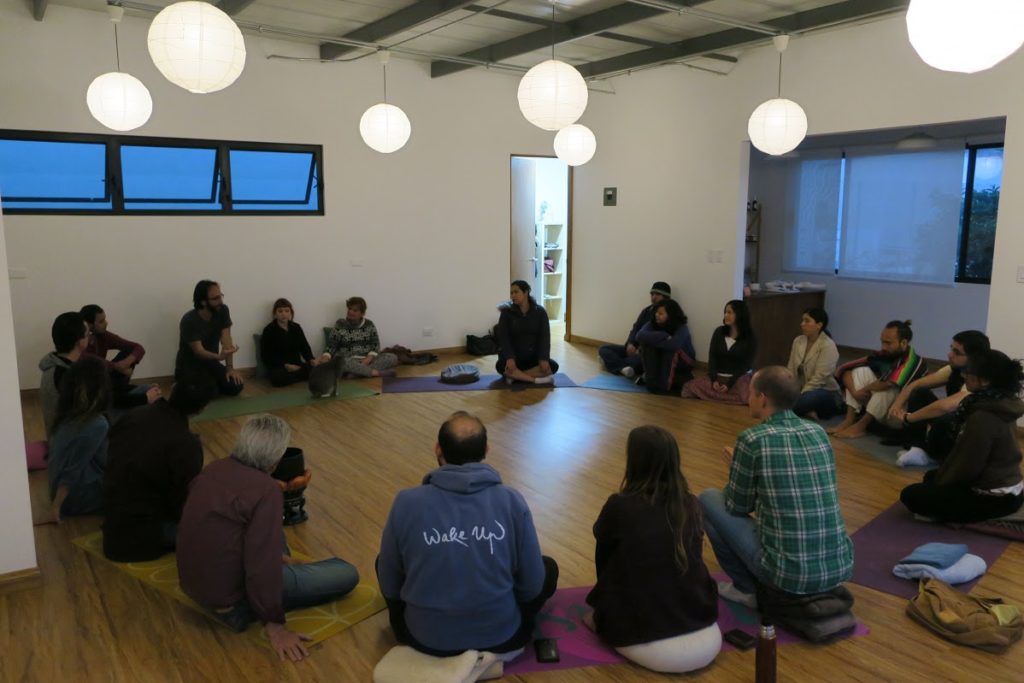 At our Wake Up Oregon retreat this past March, on the last full day together, we had the most extraordinary Dharma sharing circle that I’ve ever been a part of in the 15 years or so that I’ve been practicing. Collectively, people in the circle shared with more depth, vulnerability, trust, and courage than I’ve ever witnessed. It was both awe-inspiring, heart-opening, and humbling to experience together.
At our Wake Up Oregon retreat this past March, on the last full day together, we had the most extraordinary Dharma sharing circle that I’ve ever been a part of in the 15 years or so that I’ve been practicing. Collectively, people in the circle shared with more depth, vulnerability, trust, and courage than I’ve ever witnessed. It was both awe-inspiring, heart-opening, and humbling to experience together.
One of the most powerful forms of practice in the Plum Village tradition is Dharma sharing. Like sitting and walking meditation, it asks us to be 100% present for ourselves first, as always, and then for others. In Dharma sharing, we channel our capacities of mindfulness and concentration to tune into both the words and full expression of others as they share as well as our own body and emotional responses. It’s no less of a practice than other forms of meditation. It simply depends on our mind.
Sitting at the bell, I opened the circle with three sounds, inviting everyone to first come home deeply to themselves in order to be fully alive for our sharing together. Knowing that this was our only Dharma sharing of the retreat and intuiting that a few people had some things on their chest, but not exactly their depth, I opened the introduction by encouraging everyone to share with courageous authenticity. Knowing that fear can hold people back from sharing, I said, “That is our gift to the circle when we share, and our authentic inner world will resonate with others.” I added, “This is our one chance to really share what’s alive for us and receive the collective power of each other’s attention and compassion. So let’s not miss this opportunity.” I shared some of the other basic guidelines and opened the floor.
Behind the pain, I could hear deep hope and trust in transformation, perhaps simply because it was actually being shared openly into a room full of caring, dedicated friends.
Right off the bat, a few people didn’t hold back and poured out their suffering to the group as raw and real as it asked for. Courageous authenticity was off the charts. The first couple of sharings were very heavy, as people unveiled what they felt were the ‘dark’ and unspoken sides of themselves. There was deep trauma in the room, and for the first time in our retreat, it was shared openly, painfully, and beautifully. It was both painful to listen, difficult to embrace as well as incredibly inspiring. Behind the pain, I could hear deep hope and trust in transformation, perhaps simply because it was actually being shared openly into a room full of caring, dedicated friends.
A few of our friends who were on retreat for the first time shared with me afterward that they felt afraid that people would disperse and break up and that we couldn’t hold it together or move into a lighter space together, as it was so heavy. There was a point when I could feel the heaviness upon the hearts of everyone in the circle. Our deep listening was absorbing and even partially experiencing a sliver of the other person’s experience, sharing the suffering with them. But several of us there had been in many sharings before, and we knew the value, the deep transformative potential of this mud.
We kept breathing, listening, and attending with fierce compassion to our friends. We listened to a long sound of the bell after every sharing that was deeply emotional, inviting everyone to come back to their anchors of stability: body and breath. After those first sharings, we sat in silence for several minutes each, still taking it in, and allowing our breathing re-establish stability and ease. Eventually, others bowed into the circle, sharing their own experiences, encouragements, and faith of resiliency.
Still early on in the circle, after we had spent some minutes just breathing in silence, and the mood was still heavy and sinking, one of our retreat facilitators offered a song, a call and response that a few of us knew. People joined in slowly; soon the song filled the room with a new light, lifting us to a different plane together. We knew the suffering was still there, but we also had the brightness of this song and joy together. It’s like we were sinking in a river with heavy currents, and then suddenly, we were swimming near the banks with the river on one side of us and the forest and sunshine on the other side. The universal balance of suffering and joy was restored.
With utmost sincerity, people thanked the initial courage and openness of our friends who shared first.
Slowly, others shared their own deeply hidden suffering—suffering that had not seen the light of other people’s attention for years or ever. And with utmost sincerity, people thanked the initial courage and openness of our friends who shared first. They said, “If you had not shared so openly first, then I would not be able to share this right now.” “I’m sharing right now because I’m so moved by what they said first. It gives me the courage.” What initially felt painful, fearful, of shameful to share with others became a beacon of light and trust for others. From then on, we heard people share stories and sides of themselves that were deeply hidden gems in their hearts. But they needed the tools of compassion and safety to mine them. I wish I could share more explicitly what people said; it was so remarkable. But since confidentiality is one of the sacred tenets of Dharma sharing, I wouldn’t dare. I trust you get it.
From halfway through to the end of our session together, the compassion and connectedness in the room grew so strong that you could practically flap your arms and fly off from it. Almost everyone of us had been moved to tears by the power of others’ sharings, and not just once but several times. As a facilitator, I recognized the deep happiness of the moment and said to myself, ‘’This is why we are here. This is why we work to prepare and hold these retreats for young people. Sometimes I forget, but right now, I remember more than ever.”
After the circle had come to a close and people left the room, I watched one of our friends who was brand new to both the mindfulness practice and retreat. She had been the most quiet, introverted, and socially distant member of our retreat. She, too, was so moved by the sharings, including the power of her own expression that was previously hidden in her life. But after the circle closed, who was the first one to go up to the man who had first shared so much of his pain and suffering to the group?
Without any hesitation, she steadily walked over to him, and with a smile in her eyes, seeming to open her arms as wide as the earth to him. He smiled boyishly at the profound intimacy and care being offered in that moment and accepted her embrace. I turned halfway from them so as not to disturb their moment together. Facing just in front of our ancestor altar, I wept before the ancestors with deep gratitude for everything that had passed. This practice opens people’s hearts and fills them with compassion.
Since that extraordinary circle sharing, I’ve wondered: what conditions help to create Dharma sharing circles that are transformative, insightful, and healing? That is the question that we may ask ourselves as facilitators. Of course, not all Dharma sharings can or need to be as powerful as during a retreat. They take place in a larger environment, whether it’s a week long retreat or an evening of practice together. Everything that precedes and follows a Dharma sharing is contributing and present within that circle.
Given the range of conditions, what supports a circle to contribute to people’s relief of suffering and growth in their practice?
Here are a few things that come to mind, including for the role of a Dharma sharing facilitator:
- Inviting people to share with courageous authenticity. This is one thing we always have to offer to others when we share.
- Sharing one’s real experiences of practice and life, rather than ideas.
- As much as we are listening to others, remember to come back to one’s breath and body, grounding awareness in ourselves and the room. This is a gift to ourselves and others, and improves the quality of our listening together.
- Listening with curiosity and care to understand another person. If we notice judgment arising, we may also recognize that we’re not trying to better understand the other person; instead, we are relying on our own views. Cultivating curiosity can dismantle judgment and leaves us open to learning more about that person and ourselves.
- The practices outside of the Dharma sharing affect its quality. The quality of the sitting and walking meditation, Dharma talks, meals together, periods of silence… these all contribute to the Dharma sharing as well.
- The bonding activities between people outside of Dharma sharing and formal practices like games, playing, singing, socializing, and just hanging out. These experiences together contribute to people’s feelings of trust, safety, and harmony. Knowing that others see us for our joy and childlike playfulness, and not just our suffering and trauma, invites us to open up more to what else is there.
- I can add more, but I’m more interested in what others have to share from their experiences of Dharma sharing. Whether as a facilitator or as a participant, what forms of practice, facilitator guidance, and other conditions contribute to sharing circles that promote people’s insights, healing, and transformation? Please share your insights!
David Viafora, True Zen Mountain, has been building Wake Up Sanghas and offering Wake Up retreats in the Pacific Northwest for the past 3 years. Since May, he and his partner Vanessa are traveling around the world to research and share about the growth of intentional lay mindfulness communities in the Plum Village tradition. To hear about their exploration of lay mindfulness communities, please visit sanghabuild.org.


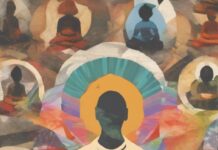
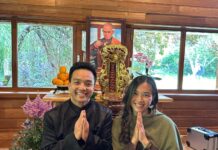
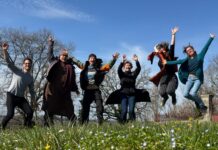
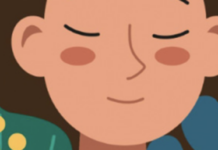
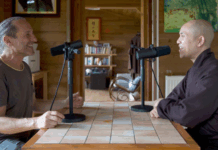
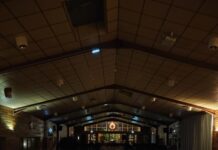
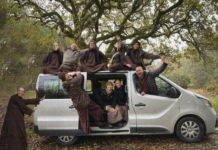
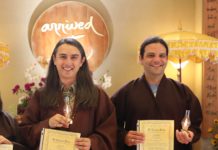
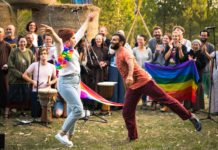
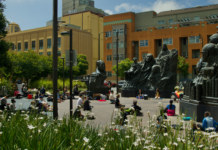


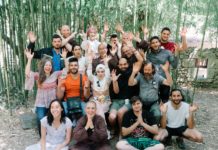

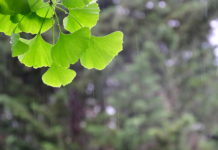
HI
I’m so happy to read this, it supports me. Since the 1st dharma sharing I attended end of 2014, every time I feel a lot of fear before going to the sharing, because what happens is that inside of me, everything is shaking and opening up during the sharing. So I bow in, I close my eyes to come back to my heart, and start to share things that I wasn’t fully aware of outside of the sharing. I saw a therapist for a few years and I never could be so openly open to my self, and to go so deep.
I often feel such an ease and liberation after the sharing, but I also feel like a freak. So I’m glad you shared this experience about very open sharing to suffering and that is what the practice of Dharma sharing is about.